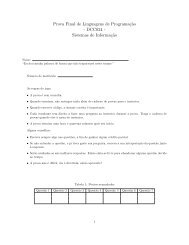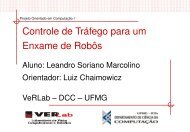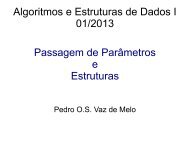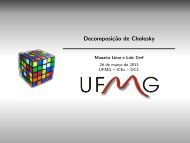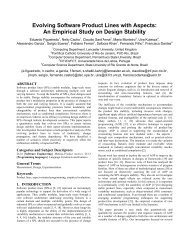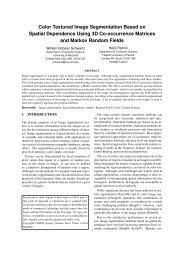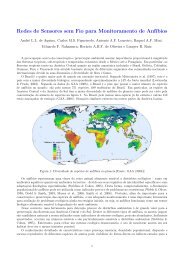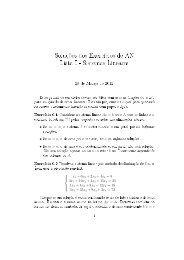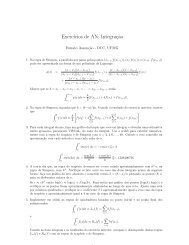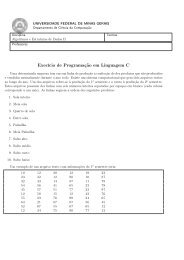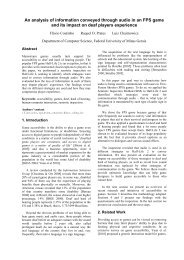Técnicas de Otimização de Código para Placas de ... - UFMG
Técnicas de Otimização de Código para Placas de ... - UFMG
Técnicas de Otimização de Código para Placas de ... - UFMG
You also want an ePaper? Increase the reach of your titles
YUMPU automatically turns print PDFs into web optimized ePapers that Google loves.
__global__ void matMulTiled ( f l o a t∗ B, f l o a t∗ C, f l o a t∗ A, i n t Width ) {<br />
__shared__ f l o a t Bs [ TILE_WIDTH ] [ TILE_WIDTH ] ;<br />
__shared__ f l o a t Cs [ TILE_WIDTH ] [ TILE_WIDTH ] ;<br />
i n t t x = threadIdx . x ;<br />
i n t t y = threadIdx . y ;<br />
/ / I d e n t i f y the row and column of the A element to work on<br />
i n t Row = b l o c k I dx . x ∗ TILE_WIDTH + t x ;<br />
i n t Col = b l o c k I d x . y ∗ TILE_WIDTH + t y ;<br />
f l o a t Pvalue = 0;<br />
/ / Loop over the B and C t i l e s r e q u ired to compute the A element<br />
for ( i n t m = 0; m < Width / TILE_WIDTH ; ++m) {<br />
/ / Coolaborative loading of B and C t i l e s i n t o shared memory<br />
Bs [ t y ] [ t x ] = B [ Col ∗ Width + (m ∗ TILE_WIDTH + t x ) ] ;<br />
Cs [ t y ] [ t x ] = C[Row + (m ∗ TILE_WIDTH + t y ) ∗ Width ] ;<br />
__syncthreads ( ) ;<br />
#pragma u n r o l l 1<br />
for ( i n t k = 0; k < TILE_WIDTH ; ++k )<br />
Pvalue += Bs [ t y ] [ k ] ∗ Cs [ k ] [ t x ] ;<br />
__syncthreads ( ) ;<br />
}<br />
A [ Col ∗ Width + Row] = Pvalue ;<br />
}<br />
Figura 1.24. Versão ladrilhada do kernel <strong>de</strong><br />
multiplicação <strong>de</strong> matrizes.<br />
gran<strong>de</strong> quantida<strong>de</strong> <strong>de</strong> informação redundante. Um quarto das<br />
instruções na figura 1.23 lêem ou escrevem dados em memória<br />
global. A fim <strong>de</strong> utilizar-se completamente a GPU, seria necessário<br />
uma banda <strong>de</strong> transmissão <strong>de</strong> dados <strong>de</strong> 173GB/s (128 threads<br />
× 1/4 × 4 Bytes × 1.35GHz), a qual é consi<strong>de</strong>ravelmente<br />
maior que a banda fornecida pela placa: 86.4GB/s. O uso eficiente<br />
da memória compartilhada po<strong>de</strong> reduzir este problema.<br />
Ladrilhamento. Uma conhecida forma <strong>de</strong> otimização <strong>de</strong> código,<br />
usada <strong>para</strong> aumentar a proximida<strong>de</strong> entre os dados manipulados<br />
<strong>de</strong>ntro <strong>de</strong> laços <strong>de</strong> execução e conhecida por ladrilhamento<br />
[21]. Nesta otimização, os dados a serem manipulados<br />
são divididos em blocos e dados nos mesmos blocos, supostamente<br />
próximos no cache, são usados em conjunto. O ladrilhamento<br />
é particularmente útil em nosso caso, pois po<strong>de</strong>mos<br />
dividir a tarefa <strong>de</strong> multiplicar duas gran<strong>de</strong>s matrizes em várias<br />
tarefas <strong>de</strong> multiplicar matrizes menores, com um mínimo <strong>de</strong> in-<br />
28



